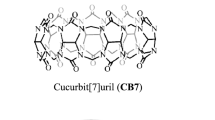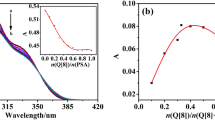Abstract
The potential increase in fluorescence of a benzimidazole-type fungicide (carbendazim) due to complexation with cucurbit[6]uril is reported. The fluorescence of the probe carbendazim in aqueous Na2SO4 solution (pH=7.61) at room temperature is found to increase by a maximum factor of ∼10.0 and blue-shifted up to ∼11±1 nm with the increase in cucurbit[6]uril concentration up to ∼5 mM. This fluorescence enhancement is the result of formation of a 1:1 guest-host inclusion complex, in which the guest carbendazim is incorporated inside the hydrophobic cavity of the host curbit[6]uril through the amido-ester part. Such mode of inclusion is supported by NMR spectral measurements, in which upon encapsulation, the resonance of the methyl-protons of the amido-ester moiety is shifted significantly to upfield in the 1H NMR spectrum. Also, to assess the formation of inclusion complex, solid samples prepared by co-evaporation have been studied, using differential scanning calorimetry (DSC). Measurement of the enhancement as a function of cucurbit[6]uril concentrations yielded a value of the equilibrium constant (K a ) of 271±10 M−1 at 25°C. From the temperature dependence of the equilibrium constants, ΔH and ΔS values have been negative in sign, indicating the dipole-dipole interactions and the steric factors associated with the formation of this inclusion complex. It might be proposed that the spectral changes due to the inclusion of carbendazim are the result of decrease in the polarity of the surrounded media rather than the loss of carbendazim rotational mobility.






Similar content being viewed by others
References
Lakowicz JR (1999) Principles of Fluorescence Spectroscopy 2nd ed, Kluwer Academic/Plenum Press, New York
Vega AB, Frenich AG, Vidal JLM (2005) Monitoring of pesticides in agricultural water and soil samples from Andalusia by liquid chromatography coupled to mass spectrometry. Anal Chim Acta 538(1–2), 117–127
Palma G, Sanchez A, Olave Y, Encina F, Palma R, Barra R (2004) Pesticide levels in surface waters in an agricultural–forestry basin in Southern. Chile Chemosphere 57:763–770
Pacioni NL, Veglia AV (2003) Determination of carbaryl and carbofuran in fruits and tap water by β-cyclodextrin enhanced fluorimetric method. Anal. Chim. Acta 488:193–202
Huston DH, Roberts TR, Jewess PJ (1999) Metabolic Pathways of Agrochemicals part 2. Instecticides and Fungicides. Royal Society of Chemistry, United Kingdom
Lezcano M, Al-Soufi W, Novo M, Rodriguez-Nunez E, Tato JV (2002) Complexation of several benzimidazole-type fungicides with α- and β-cyclodextrins. J Agric Food Chem 50:108–112
Maggio RM, Picciricci GN, Escandar GM (2005) Fluorescence enhancement of carbendazim in the presence of cyclodextrins and micellar media: a reappraisal. Appl Spectrosc 59(7):873–880
Freeman WA, Mock WL, Shih N-Y (1981) Cucurbituril. J Am Chem Soc 103:7367–7368
Freeman WA (1984) Structures of the p-xylylenediammonium chloride and calcium hydrogensulfate adducts of the cavitand’ cucurbituril’ C36H36N24O12. Acta Cryst B 40:382–387
Jun SI, Lee JW, Sakamoto S, Yamaguchi K, Kim K (2000) Rotaxane-based molecular switch with fluorescence signaling. Tetrahedron Lett 41:471–475
Buschmann H-J, Cleve E, Jansen K, Wego A, Schollmeyer E (2001) The determination of complex stabilities between different cyclodextrins and dibenzo-18-crown-6, cucurbitw6xuril, decamethylcucurbitw5xuril, cucurbitw5xuril, p-tert-butylcalixw4xarene and p-tert-butylcalixw6xarene in aqueous solutions using a spectrophotometric method. Mat Sci Eng C 14:35–39
Wagner BD, Fitzpatrick SJ, Gill MA, MacRae AI, Stojanovic N (2001) A fluorescent host–guest complex of cucurbituril in solution: a molecular Jack O’Lantern. Can J Chem 79:1101–1104
Buschmann H-J, Schollmeyer E, Mutihac L (2003) The formation of amino acid and dipeptide complexes with α-cyclodextrin and cucurbit[6]uril in aqueous solutions studied by titration calorimetry. Thermochim Acta 399:203–208
Buschmann H-J, Cleve E, Jansen K, Buschmann EH-J, Cleve E, Jansen K, Schollmeyer E (2001) Determination of complex stabilities with nearly insoluble host molecules:cucurbit[5]uril, decamethylcucurbit[5]uril and cucurbit[6]uril as ligands for the complexation of some multicharged cations in aqueous solution. Anal Chim Acta 437:157–163
Buschmanna H-J, Mutihac L, Mutihac R-C, Schollmeyer E (2005) Complexation behavior of cucurbit[6]uril with short polypeptides. Thermochim Acta 430:79–82
Buschmann H-J, Jansen K, Schollmeyer E (2003) Cucurbit[6]uril as ligand for the complexation of lanthanide cations in aqueous solution. Inorg Chem Commun 6:531–534
Buschmann H-J, Jansen K, Schollmeyer E (2000) Cucurbituril as host molecule for the complexation of aliphatic alcohols, acids and nitriles in aqueous solution. Thermochim Acta 346:33–36
Mazellier P, Leroy E, Legube B (2002) Photochemical behavior of the fungicide carbendazim in dilute aqueous solution, J Photochem Photobiol A: Chem 153:221–227
Boudina A, Emmelin C, Baaliouamer A, Grenier-Loustalot MF, Chovelon JM (2003) Photochemical behaviour of carbendazim in aqueous solution. Chemosphere 50:649–655
Acknowledgements
N. S would like to acknowledge Yarmouk University for their financial support (grant no. 2003/26).
Author information
Authors and Affiliations
Corresponding author
Rights and permissions
About this article
Cite this article
Saleh, N., Al-Rawashdeh, N.A. Fluorescence Enhancement of Carbendazim Fungicide in Cucurbit[6]uril. J Fluoresc 16, 487–493 (2006). https://doi.org/10.1007/s10895-006-0106-8
Published:
Issue Date:
DOI: https://doi.org/10.1007/s10895-006-0106-8




